brakes SKODA FABIA 2008 2.G / 5J User Guide
[x] Cancel search | Manufacturer: SKODA, Model Year: 2008, Model line: FABIA, Model: SKODA FABIA 2008 2.G / 5JPages: 252, PDF Size: 40.88 MB
Page 157 of 252
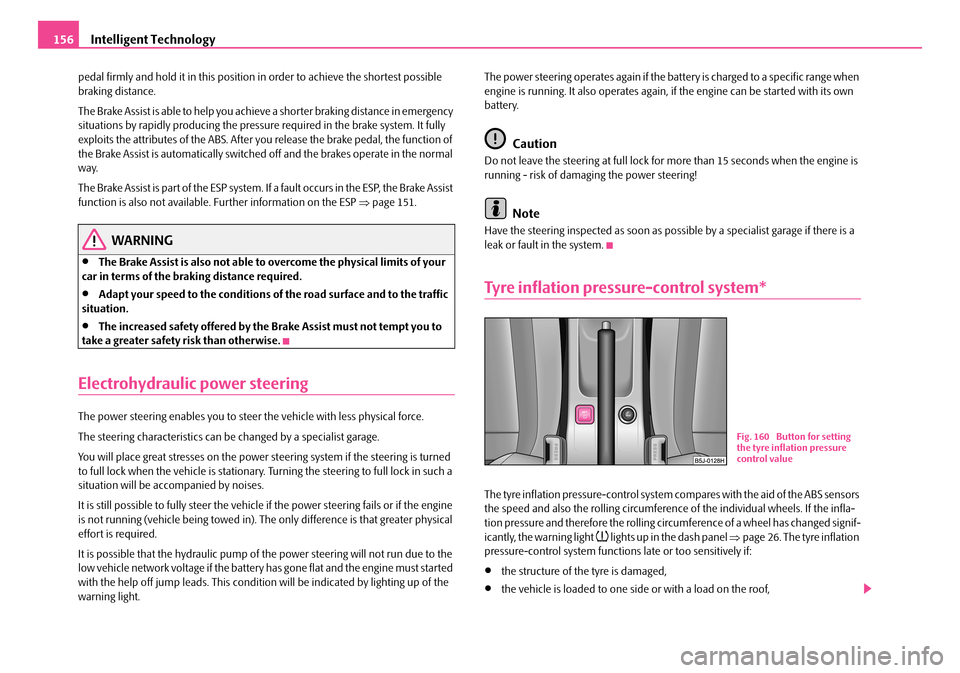
Intelligent Technology156
pedal firmly and hold it in this position in order to achieve the shortest possible braking distance.
The Brake Assist is able to help you achieve a shorter braking distance in emergency situations by rapidly producing the pressure required in the brake system. It fully exploits the attributes of the ABS. After you release the brake pedal, the function of the Brake Assist is automatically switched off and the brakes operate in the normal way.
The Brake Assist is part of the ESP system. If a fault occurs in the ESP, the Brake Assist function is also not available. Further information on the ESP ⇒page 151.
WARNING
•The Brake Assist is also not able to overcome the physical limits of your car in terms of the braking distance required.
•Adapt your speed to the conditions of the road surface and to the traffic situation.
•The increased safety offered by the Brake Assist must not tempt you to take a greater safety risk than otherwise.
Electrohydraulic power steering
The power steering enables you to steer the vehicle with less physical force.
The steering characteristics can be changed by a specialist garage.
You will place great stresses on the power steering system if the steering is turned to full lock when the vehicle is stationary. Turning the steering to full lock in such a situation will be accompanied by noises.
It is still possible to fully steer the vehicle if the power steering fails or if the engine is not running (vehicle being towed in). The only difference is that greater physical effort is required.
It is possible that the hydraulic pump of the power steering will not run due to the low vehicle network voltage if the battery has gone flat and the engine must started with the help off jump leads. This condition will be indicated by lighting up of the warning light.
The power steering operates again if the battery is charged to a specific range when engine is running. It also operates again, if the engine can be started with its own battery.
Caution
Do not leave the steering at full lock for more than 15 seconds when the engine is running - risk of damaging the power steering!
Note
Have the steering inspected as soon as possible by a specialist garage if there is a leak or fault in the system.
Tyre inflation pressure-control system*
The tyre inflation pressure-control system compares with the aid of the ABS sensors the speed and also the rolling circumference of the individual wheels. If the infla-tion pressure and therefore the rolling circumference of a wheel has changed signif-icantly, the warning light lights up in the dash panel ⇒page 26. The tyre inflation pressure-control system functions late or too sensitively if:
•the structure of the tyre is damaged,
•the vehicle is loaded to one side or with a load on the roof,
Fig. 160 Button for setting the tyre inflation pressure control value
NKO A05F 20.book Page 156 Wednesday, April 2, 2008 1:02 PM
Page 160 of 252
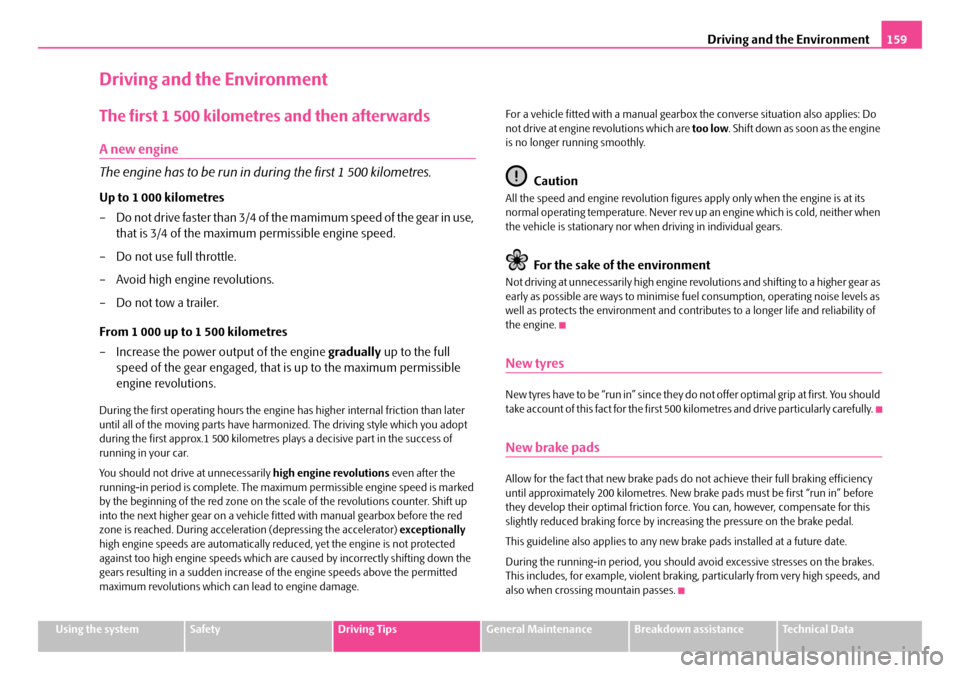
Driving and the Environment159
Using the systemSafetyDriving TipsGeneral MaintenanceBreakdown assistanceTechnical Data
Driving and the Environment
The first 1 500 kilometres and then afterwards
A new engine
The engine has to be run in during the first 1 500 kilometres.
Up to 1 000 kilometres
– Do not drive faster than 3/4 of the mamimum speed of the gear in use,
that is 3/4 of the maximum permissible engine speed.
– Do not use full throttle.
– Avoid high engine revolutions.
– Do not tow a trailer.
From 1 000 up to 1 500 kilometres
– Increase the power output of the engine gradually up to the full
speed of the gear engaged, that is up to the maximum permissible
engine revolutions.
During the first operating hours the engine has higher internal friction than later until all of the moving parts have harmonized. The driving style which you adopt during the first approx.1 500 kilometres plays a decisive part in the success of running in your car.
You should not drive at unnecessarily high engine revolutions even after the running-in period is complete. The maximum permissible engine speed is marked by the beginning of the red zone on the scale of the revolutions counter. Shift up into the next higher gear on a vehicle fitted with manual gearbox before the red zone is reached. During acceleration (depressing the accelerator) exceptionally high engine speeds are automatically reduced, yet the engine is not protected against too high engine speeds which are caused by incorrectly shifting down the gears resulting in a sudden increase of the engine speeds above the permitted maximum revolutions which can lead to engine damage.
For a vehicle fitted with a manual gearbox the converse situation also applies: Do not drive at engine revolutions which are too low. Shift down as soon as the engine is no longer running smoothly.
Caution
All the speed and engine revolution figures apply only when the engine is at its normal operating temperature. Never rev up an engine which is cold, neither when the vehicle is stationary nor when driving in individual gears.
For the sake of the environment
Not driving at unnecessarily high engine revolutions and shifting to a higher gear as early as possible are ways to minimise fuel consumption, operating noise levels as well as protects the environment and contributes to a longer life and reliability of the engine.
New tyres
New tyres have to be “run in” since they do not offer optimal grip at first. You should take account of this fact for the first 500 kilometres and drive particularly carefully.
New brake pads
Allow for the fact that new brake pads do not achieve their full braking efficiency until approximately 200 kilometres. New brake pads must be first “run in” before they develop their optimal friction force. You can, however, compensate for this slightly reduced braking force by increasing the pressure on the brake pedal.
This guideline also applies to any new brake pads installed at a future date.
During the running-in period, you should avoid excessive stresses on the brakes. This includes, for example, violent braking, particularly from very high speeds, and also when crossing mountain passes.
NKO A05F 20.book Page 159 Wednesday, April 2, 2008 1:02 PM
Page 161 of 252
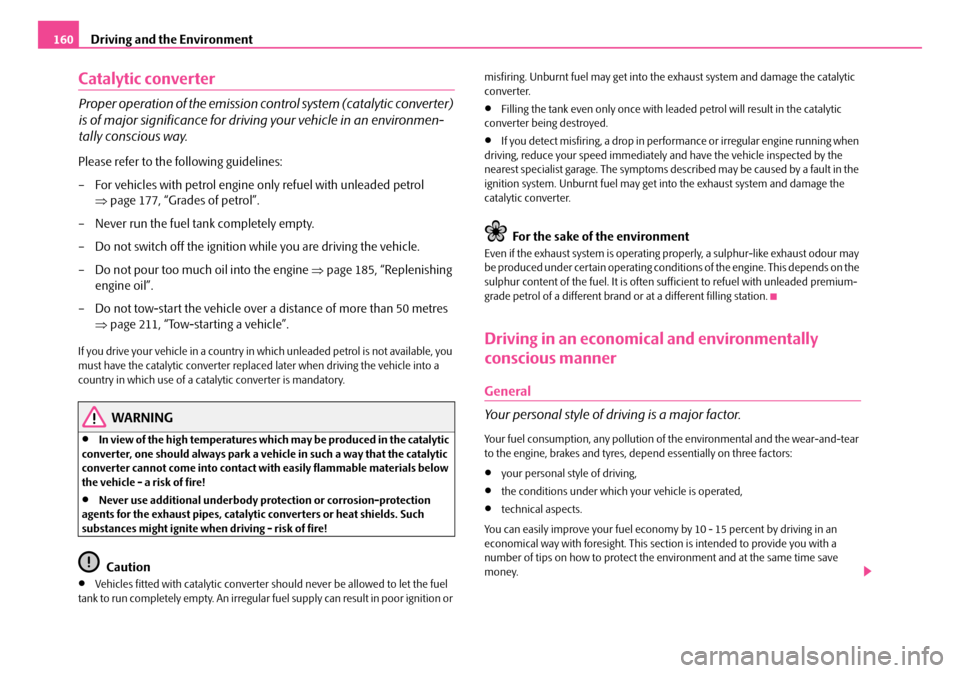
Driving and the Environment160
Catalytic converter
Proper operation of the emission control system (catalytic converter)
is of major significance for driving your vehicle in an environmen-
tally conscious way.
Please refer to the following guidelines:
– For vehicles with petrol engine only refuel with unleaded petrol
⇒page 177, “Grades of petrol”.
– Never run the fuel tank completely empty.
– Do not switch off the ignition while you are driving the vehicle.
– Do not pour too much oil into the engine ⇒page 185, “Replenishing
engine oil”.
– Do not tow-start the vehicle over a distance of more than 50 metres
⇒page 211, “Tow-starting a vehicle”.
If you drive your vehicle in a country in which unleaded petrol is not available, you must have the catalytic converter replaced later when driving the vehicle into a country in which use of a catalytic converter is mandatory.
WARNING
•In view of the high temperatures which may be produced in the catalytic converter, one should always park a vehicle in such a way that the catalytic converter cannot come into contact with easily flammable materials below the vehicle - a risk of fire!
•Never use additional underbody protection or corrosion-protection agents for the exhaust pipes, catalytic converters or heat shields. Such substances might ignite when driving - risk of fire!
Caution
•Vehicles fitted with catalytic converter should never be allowed to let the fuel tank to run completely empty. An irregular fuel supply can result in poor ignition or
misfiring. Unburnt fuel may get into the exhaust system and damage the catalytic converter.
•Filling the tank even only once with leaded petrol will result in the catalytic converter being destroyed.
•If you detect misfiring, a drop in performance or irregular engine running when driving, reduce your speed immediately and have the vehicle inspected by the nearest specialist garage. The symptoms described may be caused by a fault in the ignition system. Unburnt fuel may get into the exhaust system and damage the catalytic converter.
For the sake of the environment
Even if the exhaust system is operating properly, a sulphur-like exhaust odour may be produced under certain operating conditions of the engine. This depends on the sulphur content of the fuel. It is often sufficient to refuel with unleaded premium-grade petrol of a different brand or at a different filling station.
Driving in an economical and environmentally
conscious manner
General
Your personal style of driving is a major factor.
Your fuel consumption, any pollution of the environmental and the wear-and-tear to the engine, brakes and tyres, depend essentially on three factors:
•your personal style of driving,
•the conditions under which your vehicle is operated,
•technical aspects.
You can easily improve your fuel economy by 10 - 15 percent by driving in an economical way with foresight. This section is intended to provide you with a number of tips on how to protect the environment and at the same time save money.
NKO A05F 20.book Page 160 Wednesday, April 2, 2008 1:02 PM
Page 168 of 252
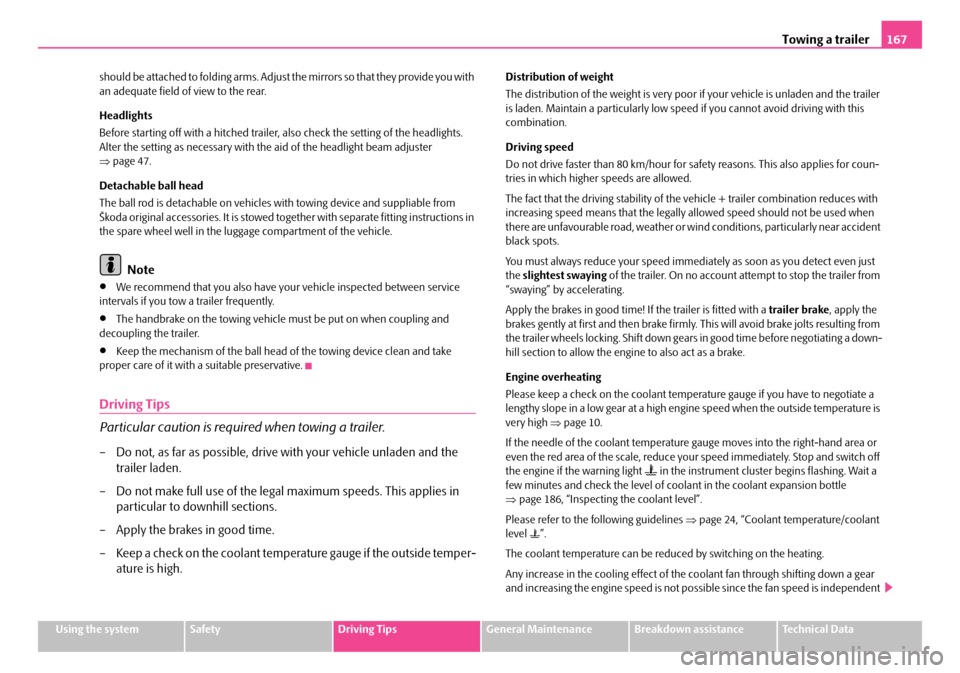
Towing a trailer167
Using the systemSafetyDriving TipsGeneral MaintenanceBreakdown assistanceTechnical Data
should be attached to folding arms. Adjust the mirrors so that they provide you with an adequate field of view to the rear.
Headlights
Before starting off with a hitched trailer, also check the setting of the headlights. Alter the setting as necessary with the aid of the headlight beam adjuster ⇒page 47.
Detachable ball head
The ball rod is detachable on vehicles with towing device and suppliable from Škoda original accessories. It is stowed together with separate fitting instructions in the spare wheel well in the luggage compartment of the vehicle.
Note
•We recommend that you also have your vehicle inspected between service intervals if you tow a trailer frequently.
•The handbrake on the towing vehicle must be put on when coupling and decoupling the trailer.
•Keep the mechanism of the ball head of the towing device clean and take proper care of it with a suitable preservative.
Driving Tips
Particular caution is required when towing a trailer.
– Do not, as far as possible, drive with your vehicle unladen and the
trailer laden.
– Do not make full use of the legal maximum speeds. This applies in
particular to downhill sections.
– Apply the brakes in good time.
– Keep a check on the coolant temperature gauge if the outside temper-
ature is high.
Distribution of weight
The distribution of the weight is very poor if your vehicle is unladen and the trailer is laden. Maintain a particularly low speed if you cannot avoid driving with this combination.
Driving speed
Do not drive faster than 80 km/hour for safety reasons. This also applies for coun-tries in which higher speeds are allowed.
The fact that the driving stability of the vehicle + trailer combination reduces with increasing speed means that the legally allowed speed should not be used when there are unfavourable road, weather or wind conditions, particularly near accident black spots.
You must always reduce your speed immediately as soon as you detect even just the slightest swaying of the trailer. On no account attempt to stop the trailer from “swaying” by accelerating.
Apply the brakes in good time! If the trailer is fitted with a trailer brake, apply the brakes gently at first and then brake firmly. This will avoid brake jolts resulting from the trailer wheels locking. Shift down gears in good time before negotiating a down-hill section to allow the engine to also act as a brake.
Engine overheating
Please keep a check on the coolant temperature gauge if you have to negotiate a lengthy slope in a low gear at a high engine speed when the outside temperature is very high ⇒page 10.
If the needle of the coolant temperature gauge moves into the right-hand area or even the red area of the scale, reduce your speed immediately. Stop and switch off the engine if the warning light in the instrument cluster begins flashing. Wait a few minutes and check the level of coolant in the coolant expansion bottle ⇒page 186, “Inspecting the coolant level”.
Please refer to the following guidelines ⇒page 24, “Coolant temperature/coolant level ”.
The coolant temperature can be reduced by switching on the heating.
Any increase in the cooling effect of the coolant fan through shifting down a gear and increasing the engine speed is not possible since the fan speed is independent
NKO A05F 20.book Page 167 Wednesday, April 2, 2008 1:02 PM
Page 190 of 252

Inspecting and Replenishing189
Using the systemSafetyDriving TipsGeneral MaintenanceBreakdown assistanceTechnical Data
One may only use new genuine brake fluid from Škoda Auto a.s. The specification for the brake fluid is “FMVSS 116 DOT 4”.
We recommend that you have the brake fluid replaced by a Škoda Service Partner as part of an Inspection Service.
WARNING
•Using old brake fluid can result in severe stress on the brakes because of the formation of vapour bubbles in the brake system. This greatly impairs the braking efficiency and thus also the safety of your vehicle.
•Brake fluid is toxic! It must therefore be kept safely in closed original containers and well away from children and unauthorized persons.
Caution
Brake fluid damages the paintwork of the vehicle.
For the sake of the environment
In view of the problems involved with proper disposal of brake fluid, the special tools and the professional knowledge required, we recommend you have the brake fluid replaced by a Škoda Service Partner.
Battery
Working on the battery
The battery is located in the engine compartment below a plastic box.
– Unlock the interlock on the positive terminal side of the battery
⇒fig. 174.
– Open the cover in direction of arrow.
– The installation of the battery cover on the positive terminal side takes
place in the reverse order.
Removal and installation of the battery is not recommended since it can, under certain circumstances, lead to major damage to the battery and fuse boxes. Contact a specialist garage.
There is a risk of injuries, scalding, accidents and burns when carrying out any work on the battery and on the electrical system. For this reason, it is essential to comply with the warning instructions ⇒ stated below and with the general applicable rules of safety.
Fig. 174 The battery: Open up the cover
NKO A05F 20.book Page 189 Wednesday, April 2, 2008 1:02 PM
Page 244 of 252
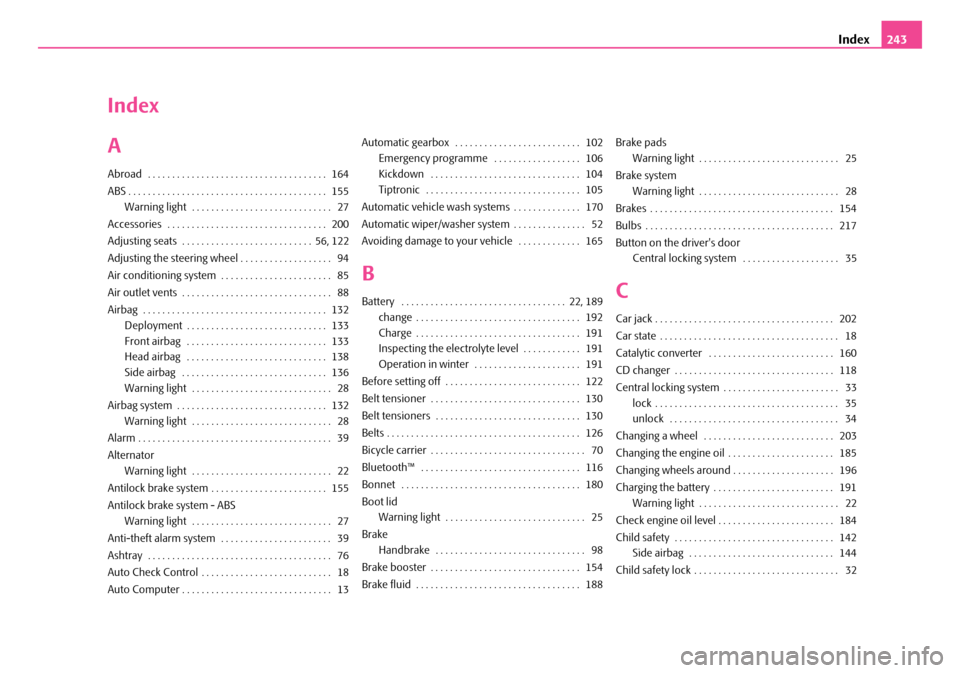
Index243
Index
A
Abroad . . . . . . . . . . . . . . . . . . . . . . . . . . . . . . . . . . . . . 164
ABS . . . . . . . . . . . . . . . . . . . . . . . . . . . . . . . . . . . . . . . . . 155
Warning light . . . . . . . . . . . . . . . . . . . . . . . . . . . . . 27
Accessories . . . . . . . . . . . . . . . . . . . . . . . . . . . . . . . . . 200
Adjusting seats . . . . . . . . . . . . . . . . . . . . . . . . . . . 56, 122
Adjusting the steering wheel . . . . . . . . . . . . . . . . . . . 94
Air conditioning system . . . . . . . . . . . . . . . . . . . . . . . 85
Air outlet vents . . . . . . . . . . . . . . . . . . . . . . . . . . . . . . . 88
Airbag . . . . . . . . . . . . . . . . . . . . . . . . . . . . . . . . . . . . . . 132
Deployment . . . . . . . . . . . . . . . . . . . . . . . . . . . . . 133
Front airbag . . . . . . . . . . . . . . . . . . . . . . . . . . . . . 133
Head airbag . . . . . . . . . . . . . . . . . . . . . . . . . . . . . 138
Side airbag . . . . . . . . . . . . . . . . . . . . . . . . . . . . . . 136
Warning light . . . . . . . . . . . . . . . . . . . . . . . . . . . . . 28
Airbag system . . . . . . . . . . . . . . . . . . . . . . . . . . . . . . . 132
Warning light . . . . . . . . . . . . . . . . . . . . . . . . . . . . . 28
Alarm . . . . . . . . . . . . . . . . . . . . . . . . . . . . . . . . . . . . . . . . 39
Alternator
Warning light . . . . . . . . . . . . . . . . . . . . . . . . . . . . . 22
Antilock brake system . . . . . . . . . . . . . . . . . . . . . . . . 155
Antilock brake system - ABS
Warning light . . . . . . . . . . . . . . . . . . . . . . . . . . . . . 27
Anti-theft alarm system . . . . . . . . . . . . . . . . . . . . . . . 39
Ashtray . . . . . . . . . . . . . . . . . . . . . . . . . . . . . . . . . . . . . . 76
Auto Check Control . . . . . . . . . . . . . . . . . . . . . . . . . . . 18
Auto Computer . . . . . . . . . . . . . . . . . . . . . . . . . . . . . . . 13
Automatic gearbox . . . . . . . . . . . . . . . . . . . . . . . . . . 102
Emergency programme . . . . . . . . . . . . . . . . . . 106
Kickdown . . . . . . . . . . . . . . . . . . . . . . . . . . . . . . . 104
Tiptronic . . . . . . . . . . . . . . . . . . . . . . . . . . . . . . . . 105
Automatic vehicle wash systems . . . . . . . . . . . . . . 170
Automatic wiper/washer system . . . . . . . . . . . . . . . 52
Avoiding damage to your vehicle . . . . . . . . . . . . . 165
B
Battery . . . . . . . . . . . . . . . . . . . . . . . . . . . . . . . . . . 22, 189
change . . . . . . . . . . . . . . . . . . . . . . . . . . . . . . . . . . 192
Charge . . . . . . . . . . . . . . . . . . . . . . . . . . . . . . . . . . 191
Inspecting the electrolyte level . . . . . . . . . . . . 191
Operation in winter . . . . . . . . . . . . . . . . . . . . . . 191
Before setting off . . . . . . . . . . . . . . . . . . . . . . . . . . . . 122
Belt tensioner . . . . . . . . . . . . . . . . . . . . . . . . . . . . . . . 130
Belt tensioners . . . . . . . . . . . . . . . . . . . . . . . . . . . . . . 130
Belts . . . . . . . . . . . . . . . . . . . . . . . . . . . . . . . . . . . . . . . . 126
Bicycle carrier . . . . . . . . . . . . . . . . . . . . . . . . . . . . . . . . 70
Bluetooth™ . . . . . . . . . . . . . . . . . . . . . . . . . . . . . . . . . 116
Bonnet . . . . . . . . . . . . . . . . . . . . . . . . . . . . . . . . . . . . . 180
Boot lid
Warning light . . . . . . . . . . . . . . . . . . . . . . . . . . . . . 25
Brake
Handbrake . . . . . . . . . . . . . . . . . . . . . . . . . . . . . . . 98
Brake booster . . . . . . . . . . . . . . . . . . . . . . . . . . . . . . . 154
Brake fluid . . . . . . . . . . . . . . . . . . . . . . . . . . . . . . . . . . 188
Brake pads
Warning light . . . . . . . . . . . . . . . . . . . . . . . . . . . . . 25
Brake system
Warning light . . . . . . . . . . . . . . . . . . . . . . . . . . . . . 28
Brakes . . . . . . . . . . . . . . . . . . . . . . . . . . . . . . . . . . . . . . 154
Bulbs . . . . . . . . . . . . . . . . . . . . . . . . . . . . . . . . . . . . . . . 217
Button on the driver's door
Central locking system . . . . . . . . . . . . . . . . . . . . 35
C
Car jack . . . . . . . . . . . . . . . . . . . . . . . . . . . . . . . . . . . . . 202
Car state . . . . . . . . . . . . . . . . . . . . . . . . . . . . . . . . . . . . . 18
Catalytic converter . . . . . . . . . . . . . . . . . . . . . . . . . . 160
CD changer . . . . . . . . . . . . . . . . . . . . . . . . . . . . . . . . . 118
Central locking system . . . . . . . . . . . . . . . . . . . . . . . . 33
lock . . . . . . . . . . . . . . . . . . . . . . . . . . . . . . . . . . . . . . 35
unlock . . . . . . . . . . . . . . . . . . . . . . . . . . . . . . . . . . . 34
Changing a wheel . . . . . . . . . . . . . . . . . . . . . . . . . . . 203
Changing the engine oil . . . . . . . . . . . . . . . . . . . . . . 185
Changing wheels around . . . . . . . . . . . . . . . . . . . . . 196
Charging the battery . . . . . . . . . . . . . . . . . . . . . . . . . 191
Warning light . . . . . . . . . . . . . . . . . . . . . . . . . . . . . 22
Check engine oil level . . . . . . . . . . . . . . . . . . . . . . . . 184
Child safety . . . . . . . . . . . . . . . . . . . . . . . . . . . . . . . . . 142
Side airbag . . . . . . . . . . . . . . . . . . . . . . . . . . . . . . 144
Child safety lock . . . . . . . . . . . . . . . . . . . . . . . . . . . . . . 32
NKO A05F 20.book Page 243 Wednesday, April 2, 2008 1:02 PM